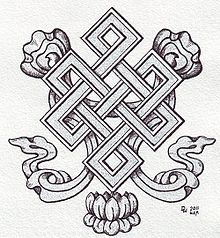|
Endless knot
   The endless knot or eternal knot is a symbolic knot and one of the Eight Auspicious Symbols. It is an important symbol in Hinduism, Jainism and Buddhism. It is an important cultural marker in places significantly influenced by Tibetan Buddhism such as Tibet, Mongolia, Tuva, Kalmykia, and Buryatia. It is also found in Celtic, Kazakh and Chinese symbolism. HistoryThe endless knot appears on clay tablets from the Indus Valley civilization (2500 BC)[1] and on a historic era inscription.[2] While associated with Dharmic religions, it also appears in Islamic art.[3][4] It likely was introduced due to trade and other cultural contact with China, the Mongols, and Iran.[5] InterpretationsBuddhismVarious Buddhist interpretations of the symbol are:
HinduismIn Hinduism, Srivatsa is mentioned as 'connected to shree', i.e the goddess Lakshmi. It is a mark on the chest of Vishnu where his consort Lakshmi resides. According to the Vishnu purana, the tenth avatar of Vishnu, Kalki, will bear the Shrivatsa mark on his chest. It is one of the names of Vishnu in the Vishnu Sahasranamam. Srivatsa is considered to be auspicious symbol in Andhra Pradesh, Telangana, Tamil Nadu and Karnataka. JainismIn Jainism it is one of the eight auspicious items, an asthamangala, however found only in the Svetambara sect. It is often found marking the chests of the 24 tirthankaras. It is more commonly referred to as the Shrivatsa. LogoA stylized version of the endless knot is the logo of China Unicom. See alsoNotes and references
External linksWikimedia Commons has media related to Endless knots.
|
||||||||||||||||||||||||||||||||||||||
